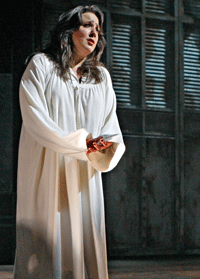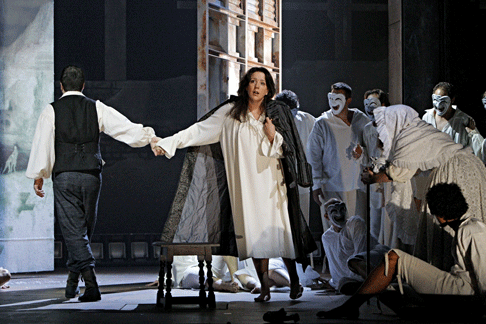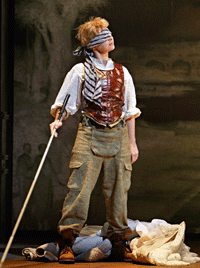28 Sep 2010
Orpheo ed Eurydice in Minnesota
Minnesota Opera pulled out all the stops for its 2010-2011 season with its production of Gluck’s Orpheo ed Eurydice.

Minnesota Opera pulled out all the stops for its 2010-2011 season with its production of Gluck’s Orpheo ed Eurydice.
Early music veteran David Daniels alongside fresh-voiced soprano Susanna Phillips headline the production. Stage director Lee Blakeley, British designer Adrian Linford, and choreographer Arthur Pita collaborate to create a visually captivating production, tapping into classical and raw humanistic elements. And with the exceptional underpinnings of the St. Paul Chamber Orchestra under the direction of baroque specialist Harry Bicket, what can be missed?
 Susanna Phillips as Euridice
Susanna Phillips as Euridice
Set in a classical-style theater proscenium, the backdrop directly alludes
to Orpheus as the symbol of music, performance and art. Eurydice’s
funeral in Act I reveals the remains of the same theater, though decaying,
casting a darkened shadow on Orpheus’ future creative life without his
beloved. As Orpheus prepares to enter the gates of Hades to retrieve Eurydice
in Act II, he climbs into the backstage of the theater, where eerie stagehands
haul decrepit set pieces from the wings and fierce Furies lurk behind the door.
The Elysian Fields appear within the theater’s depths, casting bright
light on souls descending into the afterlife from red cords dropping from the
canopy. Orpheus and Eurydice travel from Hades to the land of the living,
returning to the decrepit backstage. Only after Amore restores Eurydice’s
life in Act III does the theater return to its original luster.
Under the direction of Arthur Pita, members of the Zenon Dance Company were a fantastic addition to this production. Implementing elements of modern dance throughout the longer orchestral interludes, the choreography perfectly reflected the musical topos. The choice of modern dance to complement the Classical music was a natural choice, considering Classical composers and performers of the time of Gluck were focused on recreating ancient Greek performance. Modern movement allowed the dancers to display the perfect proportions of the human form through raw and engaging movement without artifice. Pita’s use of dancers as the furies of Hades was a bold choice, considering this is the stormiest orchestral music of the opera. Barbarically clad monsters, tied to red cords leapt at Orpheus as he tries to enter the gates of Hades. The strong orchestral rhythms allowed the dancers to move with athleticism and virility, and were quite frightening to the audience! As the drama moves to the setting of the Elysian Fields, Pita makes more strong choices involving movement and dance. Dead souls slowly drop from the canopy, amplifying the languid transition from death to life. Once descended, the souls lose their human identity when they are forced to wear the mask of comedy. Pita’s choreography of one man’s soul losing his identity was some of the most raw yet fluid dancing of the evening.
 David Daniels as Orfeo, Susanna Phillips as Euridice and Company in The Minnesota Opera
David Daniels as Orfeo, Susanna Phillips as Euridice and Company in The Minnesota Opera
Counter-tenor David Daniels shined throughout the opera. Considering Orpheus is onstage from Act I to the end, Daniels commanded every moment in the performance. Throughout recitatives and ensemble sections, he communicated with an intense musical and theatrical focus both with his fellow performers and the audience. Daniel’s “Che faro senza Euridice” was the evening’s pièce de resistance. Daniel’s middle and upper registers had such power, easily cutting over the orchestra yet maintaining a beautiful lyricism, and the yearning lines of this aria truly pulled heartstrings. Certainly Amore wasn’t the only one moved by this masterful performance.
Susanna Phillips as Eurydice was a fantastic surprise. The twenty-nine year-old soprano has found much success since her 2005 Metropolitan Opera National Council Auditions win. With a golden voice, full of warmth and richness, she was able to beautifully maneuver through Gluck’s Baroque/ Classical style with finesse and ease. Considering she has much experience with Mozart, singing Donna Anna, Donna Elvira, Pamina, and the Countess, she executed refined tapered phrasing. Her breath agility was truly surprising during her Act III duet with Orpheo, where the voices are in perfect harmony. Shading her tone to complement Mr. Daniels was executed beautifully, both voices swelled and tapered through the harmonies, revealing beautiful simplicity in the straighter tones implemented. I hope Ms. Phillips continues to perform in these earlier genres, possibly foraying into Rameau or Handel.
 Angela Mortellaro as Amore
Angela Mortellaro as Amore
Minnesota Opera’s Resident Artist, Angela Mortellaro, played a
spritely pants role as Amore, the god of love. Ingeniously clad in a blindfold
and blind cane, Mortellaro cleverly uses her props to mock Gluck’s
interlude orchestral music, imitating rhythms with her cane. Ms.
Mortellaro’s voice has a silvery, glistening quality, and her upper
register shot through the hall with ease. Much of her recitative lay in the
lower register, and was not quite as audible. However, due to maybe one or two
stands too many in the orchestra, an overpowering orchestra in some sections
seemed to be an issue for the other performers as well.
The Minnesota Opera Chorus was a bit disappointing in this production. There was a large gap in performance intensity from the beginning with Mr. Daniels juxtaposed with the chorus in the opening funeral scene. It seemed as though the ensemble members were an energy drain onstage, with little to no commitment to their individual character, as well as lacking diction and musical intensity. With so many outstanding performers, the chorus could have used more theatrical coaching and diction work to bolster the ensemble to the level of the rest of the performance.
Sarah Luebke